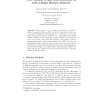Free Online Productivity Tools
i2Speak
i2Symbol
i2OCR
iTex2Img
iWeb2Print
iWeb2Shot
i2Type
iPdf2Split
iPdf2Merge
i2Bopomofo
i2Arabic
i2Style
i2Image
i2PDF
iLatex2Rtf
Sci2ools
122
click to vote
CTRSA
2005
Springer
2005
Springer
New Minimal Weight Representations for Left-to-Right Window Methods
For an integer w ≥ 2, a radix 2 representation is called a width-w nonadjacent form (w-NAF, for short) if each nonzero digit is an odd integer with absolute value less than 2w−1 , and of any w consecutive digits, at most one is nonzero. In elliptic curve cryptography, the w-NAF window method is used to efficiently compute nP where n is an integer and P is an elliptic curve point. We introduce a new family of radix 2 representations which use the same digits as the w-NAF but have the advantage that they result in a window method which uses less memory. This memory savings results from the fact that these new representations can be deduced using a very simple left-to-right algorithm. Further, we show that like the w-NAF, these new representations have a minimal number of nonzero digits. 1 Window Methods An operation fundamental to elliptic curve cryptography is scalar multiplication; that is, computing nP for an integer, n, and an elliptic curve point, P. A number of different algor...
Related Content
| Added | 26 Jun 2010 |
| Updated | 26 Jun 2010 |
| Type | Conference |
| Year | 2005 |
| Where | CTRSA |
| Authors | James A. Muir, Douglas R. Stinson |
Comments (0)

